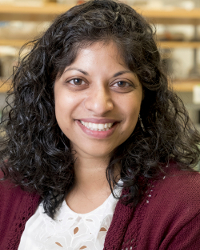Priya Rajasethupathy facts for kids
Quick facts for kids
Priya Rajasethupathy
|
|
|---|---|
| Priyamvada Rajasethupathy | |
 |
|
| Alma mater | Cornell University, BA, 2004 Columbia University, MD-PhD, 2013 |
| Awards | Searle Scholar, NIH Director's New Innovator Award |
| Scientific career | |
| Fields | Neuroscience |
| Institutions | Stanford University Rockefeller University |
| Thesis | Novel Small-RNA Mediated Gene Regulatory Mechanisms for Long-Term Memory (2012) |
| Doctoral advisor | Eric Kandel |
Priya Rajasethupathy is a brilliant scientist who studies the brain. She is a neuroscientist and a professor at Rockefeller University. There, she leads a special lab that explores how our brains learn and remember things.
Contents
Priya's Early Life and Education
Priya Rajasethupathy grew up in a town called Brockport, New York. She loved science and went to Cornell University. In 2004, she earned a degree in biology. For her college project, she studied tiny molecules called Aptamers. These molecules helped her understand how to create new ways to help with conditions like epilepsy.
After college, Priya spent a year in India. She worked with people who had mental health challenges. She also did brain research at a science center in Bangalore.
Becoming a Doctor and Scientist
Priya then went to Columbia University. She worked towards two degrees at once: a medical degree (MD) and a science PhD. For her PhD, she worked with a famous scientist named Eric Kandel.
She studied California sea slugs, which are simple animals. These slugs helped her understand how memories are made and stored. She looked at tiny molecules called non-coding RNAs inside their nerve cells.
Discoveries About Memory
Priya found a special small RNA called miR-124. It is very common in the brain and helps nerve cells change and adapt. This ability of nerve cells to change is called synaptic plasticity. It's super important for learning!
She also discovered a new type of small RNA called piRNAs. Scientists thought these were only found in certain cells. But Priya found them in brain cells too! She learned that piRNAs can make lasting changes to nerve cell connections. This might explain how we keep memories for a very long time.
Postdoctoral Research
After getting her degrees, Priya joined another lab in 2013. She worked with Karl Deisseroth, a scientist famous for a method called optogenetics. This method uses light to control brain cells.
Priya used mice to study how memories are retrieved. She found a new pathway in the brain, connecting two important areas: the prefrontal cortex and the hippocampus. This pathway is needed to remember things. She used amazing tools like optogenetics and special microscopes to watch brain cells in action.
Her work was so important that Science News named her one of the top young scientists in 2015!
Current Research at Rockefeller University
In 2017, Priya Rajasethupathy became a professor at Rockefeller University. She now leads her own lab, called the Laboratory of Neural Dynamics & Cognition.
Her team continues to explore how memories form, become stable, and change over time. They watch and control brain circuits in animals. This helps them understand how the brain works when animals are learning or remembering.
Priya's research is supported by a special award called the NIH Director's New Innovator Award. This award helps young scientists work on exciting, high-risk projects. She received $2.5 million over five years to support her important work.
Awards and Honors
- Harold M. Weintraub Graduate Student Award, Fred Hutchinson Cancer Research Center, 2012
- Top 10 Early Career Scientists, Science News, 2015
- NIH Director's New Innovator Award, 2017
- Searle Scholar, 2018
- Klingenstein-Simons Fellow, Simons Foundation and the Esther A. and Joseph Klingenstein Fund, 2018

